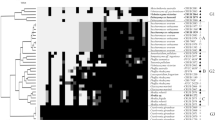Abstract
The cell composition of bakers' yeast in a continuous culture was determined for different dilution rates. Also, the cellular response to heat stress in terms of trehalose, RNA, glycogen and protein was determined at a specified dilution rate of 0.1/h. The amount of storage saccharides, trehalose and glycogen, was found to decrease whereas the amount of RNA and protein increased with increasing dilution rates. As the dilution rate was increased from 0.1 to 0.4/h at 0.05 intervals the steady-state trehalose content decreased from 33 to 8.6 mg/g biomass, and glycogen content from 150 to 93 mg/g biomass. On the other hand, the protein content increased from 420 to 530 mg/g biomass and the RNA content from 93 to 113 mg/g biomass. Heat stress was applied by increasing the medium temperature from 30 to 36, 38 or 40°C at constant dilution rates. The highest amount of trehalose accumulation, 108 mg/g biomass, was achieved when heat stress at 38°C was applied. The protein content, on the other hand, decreased from 350 to 325 mg/g biomass at the end of the experiment.
Similar content being viewed by others
References
Dubois M., Gilles K.A., Hamilton J.K., Rebers P.A., Smith F.: Colorimetric method for determination of sugars and related substances.Anal. Chem. 28, 350–356 (1956).
European Brewery Convention—Analytica Microbiologica. J. Inst. Brew. 83, 109–118 (1977).
Hartree E.F.: Determination of protein: A modification of the Lowry method that gives a linear photometric response.Anal. Biochem. 48, 422–427 (1972).
Herbert D., Phipps P.J., Strange R.E.: Chemical analysis of microbial cells, pp. 209–344 inMethods in Microbiology (J.R. Norris, D.W. Ribbons, Eds.), Vol. 58. Academic Press, London 1971.
Küenzi M.T., Fiechter A.: Regulation of carbohydrate composition ofSaccharomyces cerevisiae under growth limitation.Arch. Microbiol. 84, 254–265 (1972).
Lillie S.H., Pringle J.R.: Reserve carbohydrate metabolism inSaccharomyces cerevisiae. Response to nutrient limitation.J. Bacteriol. 143, 1384–1394 (1980).
Londesborough J., Vuorio O.E.: Purification of trehalose synthase from bakers' yeast. Its temperature-dependent activation by fructose-6-phosphate and inhibition by phosphate.Eur. J. Biochem. 216, 841–848 (1993).
Neves M.J., François J.: On the mechanism by which a heat shock induces trehalose accumulation inSaccharomyces cerevisiae.Biochem. J. 288, 859–864 (1992).
Panek A.C., Mansure-Vania J.J., Paschoalin M.F., Panek D.: Regulation of trehalose metabolism inSaccharomyces cerevisiae mutants during temperature shifts.Biochimie 72, 77–79 (1990).
Panek A.D., Mattoon J.R.: Regulation of energy metabolism inSaccharomyces cerevisiae.Arch. Biochem. Biophys. 183, 306–316 (1977).
Pejin D., Razmovski R.: Continuous cultivation on the yeastSaccharomyces cerevisiae at different dilution rates and glucose concentrations in nutrient media.Folia Microbiol. 38, 141–146 (1993).
Rao P., Pattabiraman T.N.: Reevaluation of the phenol-sulfuric acid reaction for the estimation of hexoses and pentoses.Anal. Biochem. 181, 18–22 (1989).
Ribeiro M.J.S., Silva J.T., Panek A.D.: Trehalose metabolism inSaccharomyces cerevisiae during heat shock.Biochim. Biophys. Acta 1200, 139–147 (1994).
Stewart P.R.: Analytical methods for yeasts, pp. 11–145 inMethods in Cellular Biology (D.W. Prescott, Ed.), Vol. 12. Academic Press, New York 1975.
de Virgilio C., Simmen U., Hottiger T., Boller T., Wiemken A.: Heat shock induces enzymes of trehalose metabolism, trehalose accumulation, and thermotolerance inSchizosaccharomyces pombe, even in the presence of cycloheximide.FEBS Lett. 273, 107–110 (1990).
Winkler K., Kienle I., Burgert M., Wagner J.C., Holzer H.: Metabolic regulation of the trehalose content of vegetative yeast.FEBS Lett. 291, 269–272 (1991).
Author information
Authors and Affiliations
Rights and permissions
About this article
Cite this article
Ertugay, N., Hamamci, H. Continuous cultivation of bakers' yeast: Change in cell composition at different dilution rates and effect of heat stress on trehalose level. Folia Microbiol 42, 463–467 (1997). https://doi.org/10.1007/BF02826554
Received:
Revised:
Issue Date:
DOI: https://doi.org/10.1007/BF02826554




